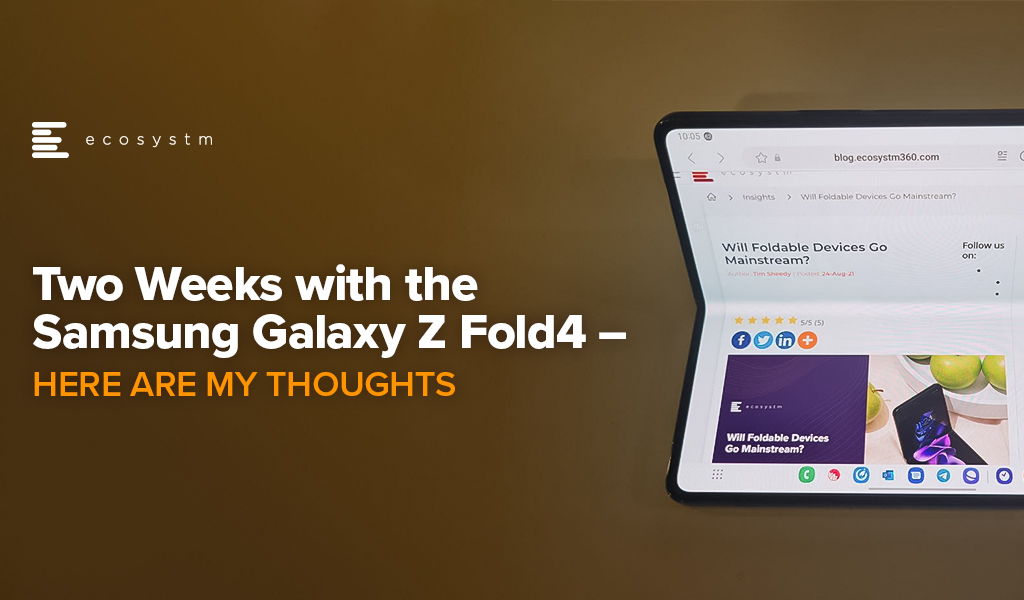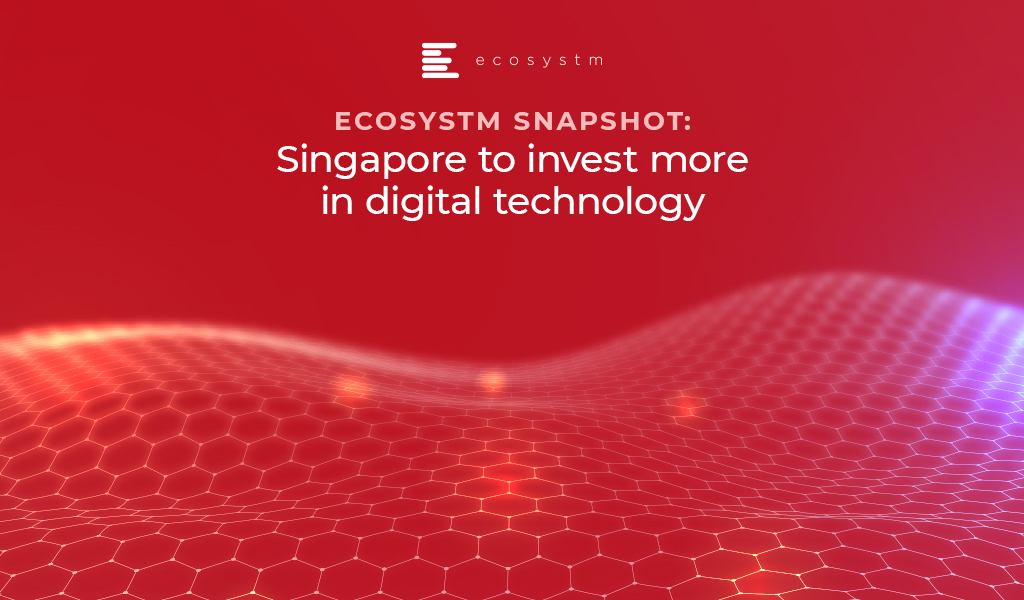If you have been following my insights and blogs at Ecosystm, it won’t come as a surprise that I am a fan of foldable devices. I have owned the Z Fold3 for over a year now. In that year, I found myself reaching for my tablet less often as the larger screen on the Z Fold3 was enough for most of my needs. Most apps were resized appropriately and provided an improved user experience, and the upgraded OS with a MacOS style application bar made it even easier to switch between applications.
The larger screen of the foldable form factor boosted my productivity too – I could use multiple applications and respond to an email with the content’s source (PDF, Excel file, website, etc.) also open – meaning far less flicking between apps, which isn’t as easy on a smartphone compared to a laptop or a desktop computer. The computer style view for messages and emails (with the email list on the left and the actual email on the right) was brilliant. And I enjoyed using the external screen as a preview screen for taking selfies (I already have my work cut out in making selfies look good! So, being able to see the picture in advance helps a lot).
However, Fold3 had its imperfections. The slightly narrow front screen made typing difficult when the device was folded – I primarily used it to check the status of things (such as turning my coffee machine on/off, checking my solar production, etc.). The inside screen also had durability issues. After a year, Samsung installed screen protector was coming off, and then, the right inner screen gave up completely on me. That said, Samsung has been excellent at fixing these issues under warranty.
Samsung Galaxy Z Fold4 – Enhanced Features
With the launch of the new Z Fold4, I was keen to get my hands on a trial device, and the good people at Samsung and their PR agency arranged that for me. I have now spent two weeks with this device. Despite it being similar in size to the Z Fold3, the upgrades do make a real difference:
- The few extra mm of width on the front screen makes it much more usable – I can now use this screen for typing messages and entering data. I still prefer the larger screen for things such as consuming content and typing longer emails. But the outside screen is usable for more than just checking the status of systems or apps.
- The shorter height and the wider screen mean that the inside screen now feels more “expansive” – more of a tablet experience – and is getting closer to an iPad mini. This makes consuming and creating content easier and more enjoyable. As an avid tablet user, even with the Z Fold3, I would hesitate when going out, wondering if I needed to take my iPad with me. I noticed that I did not hesitate with the Z Fold4 – I was fine without my tablet.
- Typically, newer phones feature improved cameras. This is certainly the case with the Z Fold4 – the camera feels faster than the Fold3, taking lesser time to focus and take pictures. And the images too are sharper and richer.
- The screen warranty has also improved – perhaps in acknowledgement of the issues with the Z Fold3 screen. There are specials offering screen replacements for a low cost, even if you damage the screen, as well as discounts on Samsung Care+, which offers two replacement devices in 24 months.
The only comment I have is that it is the most slippery phone I have used so far! It didn’t come with a protective case and in two weeks, I have dropped this phone more times than I have dropped any other phone in the past few years! It has slipped off seats and desks as well as out of my pocket and hands. Although, it does claim to “stand up to life’s bumps and fumbles” and this has been accurate so far (as it does not even have a scratch on it yet – which is a surprise as it has hit wood, tiles, and concrete pretty hard!). But if I were keeping the device for any longer, I would immediately purchase a case!
Who Will Use It Most?
Whether this device is right for you depends on your device use patterns. I do believe there is a case for businesses to invest in foldables – particularly for employees who share content one on one with clients or prospects, or those who want to be more productive and be away from their desks without lugging a laptop. Anyone who is considering a flagship phone with a larger screen (iPhone Pro Max or Pixel 7 Pro) should take a look at the Samsung Galaxy Z Fold4. You will be pleasantly surprised with the quality and capability of this device. I know I will be sad to see it go when I hand it back to Samsung!

The future of food, medicine, and digital technology has been marked as prime research targets to maintain Singapore’s competitiveness in the coming years. Recently, Singapore Government convened a panel discussion on the Research, Innovation and Enterprise (RIE) 2020 plan where Singapore’s Finance Minister Mr Heng Swee Keat delivered an update on Singapore’s science and technology research plan.
Mr. Heng conveyed that more than S$500 million is set-aside to shape up the artificial intelligence systems and to fulfill the nation’s cyber-security requirements. The fund will also improve Singapore’s supercomputing capabilities and the deployment of automation and robotics.
A further $144 million will be allocated towards food research to increase sustainable urban food production, and another $80 million will be contributed to the cell-therapy research in the biopharmaceutical sector.
How Singapore will benefit in terms of technology from this announcement?
The Government has clearly spent a lot of time to determine how to get Singaporean companies to invest in research that can benefit the country, and identifying areas that the industries can benefit in return.
Investment in Digital Technology
The Government believes that it is important to invest in the areas of Artificial Intelligence, Supercomputing and Robotics and hope that there will be more success stories for these industries. The S$500 million set aside will aim to increase the funding already set back in the RIE 2020 for the Digital Intelligence.
Speaking on the subject, Mervyn Cheah, Principal Advisor ,Ecosystm, says that “The Government aims to entice more Industry to invest in R&D in Singapore. PM Lee has mentioned that the industry today is investing just 1.2 to 1.4 of Singapore’s GDP in R&D in Singapore, and he wants the Industry to do more. It is a bit like playing roulette you place your bets on many numbers and hope that one of them will blossom and give you the returns and success. It is not possible that all R&D will come to fruition practically.”
Scenario for Businesses
The RIE 2020 is an initiative taken by the Singapore Government to make the nation a hub for R&D. By setting aside funds for both local industries and MNCs the government hopes that the industries will be able to invest and grow.
“There are a number of new start-ups being created as Singaporeans start to recognise that the government is putting in more R&D funding. At the same time, existing businesses will expand to take advantage of this announcement” says Cheah.
What to Expect – RIE2020
Currently, the local Industries in Singapore do not have a large appetite for investing in R&D in Singapore although there is a 50% spike from 2016 to 2018. The government’s aim is to invest in the Science, Engineering, and Biomedical fields industries, with the intent that they can increase their revenue.
Cheah says “the Government is looking at getting Multi-national Corporations (MNCs) to invest in Singapore for their R&D and believes that the industry can do better. So, the Government (National Research Foundation under the Prime Minister’s Office) is pushing the Industry to do more, and on their pro-active part, they have announced setting aside another S$700 million R&D funding to A*STAR, to the Singapore Food Agency, and other R&D agencies, with the hope that the Industries will further spend R&D in Singapore.”



